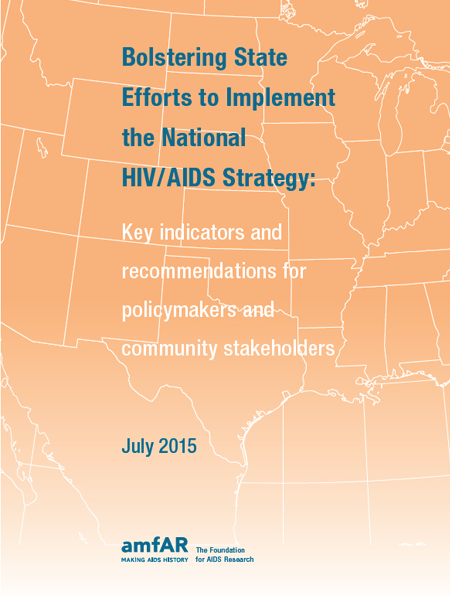 Report urges stronger, more consistent state leadership to help end the AIDS epidemic in the United States.
Report urges stronger, more consistent state leadership to help end the AIDS epidemic in the United States.
Major achievements have been made in the domestic HIV/AIDS response as a result of increased realignment and coordination of efforts at the federal level. However, that level of consistent coordination and alignment has yet to take place in most states. In an effort to identify what needs to be done, amfAR, The Foundation for AIDS Research, in collaboration with the National HIV/AIDS Initiative at the O’Neill Institute for National and Global Health Law at Georgetown Law, has released a set of recommendations for how states across the U.S. can improve HIV prevention and care outcomes in an effort to achieve the goals identified within the National HIV/AIDS Strategy.
The report, “Bolstering State Efforts to Implement the National HIV/AIDS Strategy: Key indicators and recommendations for policymakers and community stakeholders,” builds upon the Centers for Disease Control and Prevention’s (CDC) 2014 “State Prevention Progress Report,” which provided state-level data on indicators related to national HIV prevention goals. The release of the report coincides with the release by the White House Office of National AIDS Policy of the National HIV/AIDS Strategy Update, which sets priorities to guide the nation’s HIV response through 2020.
While significant progress has been made since the release of the National HIV/AIDS Strategy in 2010, the report indicates that states can, and should, do more to align their efforts with the national goals of 1) reducing new infections; 2) increasing access to care and improving health outcomes for people with HIV; and 3) reducing HIV-related health disparities.
“The burden of HIV, and the response to it, varies across states due to a number of social, political and economic factors,” said Jeffrey S. Crowley, Program Director of the National HIV/AIDS Initiative at the O’Neill Institute for National and Global Health Law and a lead author of the report. “But we have found that if states focus on a handful of priority action steps and implement them successfully, they can begin to close critical gaps and dramatically accelerate progress toward ending their HIV epidemics.” Crowley served as the Director of the White House Office of National AIDS Policy and Senior Advisor on Disability Policy from 2009-2011. In this role, he led the development of the National HIV/AIDS Strategy for the United States.
Among its recommendations, the report urges states to target their resources and services to key populations bearing the brunt of the epidemic, especially gay men and other men who have sex with men. Despite representing the greatest percentage of all new HIV infections in each state, neither federal programs nor state health departments have adequately targeted funding to this population.
The report also recommends that barriers that prevent access to care and treatment services should be removed. This includes expanding access to Medicaid, the source of healthcare coverage for the majority of uninsured people living with HIV, under the Affordable Care Act. According to the report, 21 states have not expanded Medicaid, including 10 states in the South, a region disproportionately affected by the epidemic.
To help reduce HIV stigma and to support current public health approaches to fighting HIV, states should re-evaluate and modernize laws related to exposure to HIV that are outdated and inconsistent with scientific evidence. Thirty-three states currently have laws that criminalize the transmission of HIV and 38 states use general criminal laws to prosecute people with HIV for failure to disclose their status.
And in an effort to reduce HIV infections, all states should require the reporting of all CD4 and viral load tests, essential data deemed necessary to build a robust continuum of care in each state. The collection of this data will enable policy makers to make more informed decisions based on epidemiology in the state, and will improve efforts to reduce HIV incidence, disparity and mortality.
“The report tells us that many states have made incredible progress in effectively implementing the nation’s HIV goals,” said Brian Honermann, senior policy adviser of amfAR and co-author of the report. “As we look to implement the next five years of the National HIV/AIDS Strategy, we hope that state officials and community stakeholders see this as a useful tool to help strengthen their HIV programs and make further progress toward ending the AIDS epidemic in America.”
The full report, including state-by-state analyses of key indicators and recommendations, can be downloaded here.
About amfAR
amfAR, The Foundation for AIDS Research, is one of the world’s leading nonprofit organizations dedicated to the support of AIDS research, HIV prevention, treatment education, and the advocacy of sound AIDS-related public policy. Since 1985, amfAR has invested $415 million in its programs and has awarded grants to more than 3,300 research teams worldwide. Learn more about amfAR at www.amfar.org.
About Jeffrey Crowley
Mr. Crowley is the Program Director of the National HIV/AIDS Initiative at the O’Neill Institute for National and Global Health Law and Distinguished Scholar. He is a widely recognized expert on HIV/AIDS and disability policy. He served as the Director of the White House Office of National AIDS Policy and Senior Advisor on Disability Policy from 2009-2011. In this role, he led the development of the 2010 National HIV/AIDS Strategy for the United States.
Latest
India and the IHR Amendments: Strengthening Legal Preparedness for Global Health Security
Kashish Aneja Lawrence O. Gostin Sam Halabi



